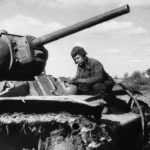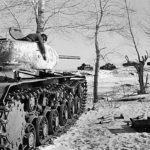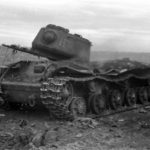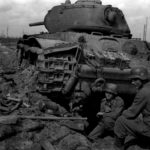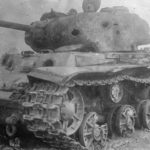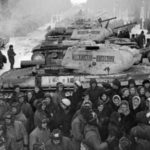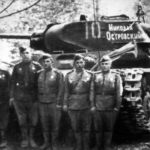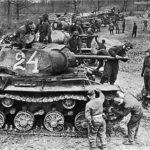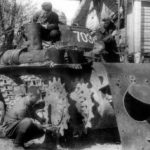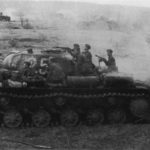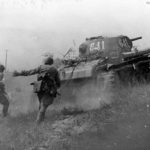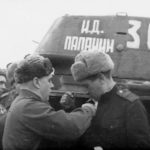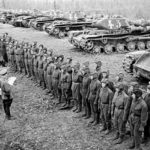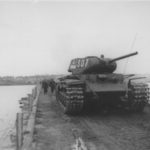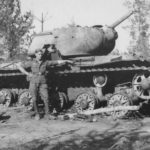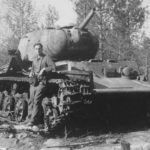KV-1S of the 9th Guards Heavy Tank Regiment, Kursk 1943
An official propaganda photo of a tank after combat, Voronezh Front 1943
Destroyed KV-1S 2
Germans and KV-1S 1943
Destroyed KV-1S
KV-1S with winter camouflage, Moscow December 1942
Crew and their KV-1S “White 10” of the 13th Guards Tank Regiment
KV-1S “White 24” of the 6th Guards Heavy Tank Regiment
KV-1S “White 703” of the 31st Guards Heavy Tank Regiment 1944
KV-1S tanks of the 6th Guards Heavy Tank Regiment 2
KV-1S “641” of 260th Separate Guards Heavy Tank Regiment 1944
KV-1S “White 307”
KV-1S tanks of 6th Guards Heavy Tank Regiment 1943
KV-1S “White 307” 2
Soviet heavy tank KV-1S
KV-1S heavy tank
A lighter variant of KV from late 1942 with higher speed, but lowered armor. There were also numerous technical improvements and a redesign of the rear hull. 1086 were built before production ended in August 1943.
This combat vehicle was developed by the design bureau of the Chelyabinsk Tractor Plant (ChTZ) in May – July 1942 in connection with complaints of commanders of the Workers’ and Peasants’ Red Army (RKKA) about low mobility and reliability of the original version of the KV-1 heavy tank. In order to reduce the total weight of the tank, its dimensions were somewhat reduced and the armouring was weakened. As a result of these measures, the average and maximum speeds of the tank were increased. Together with the introduction of the new gearbox, it was possible to slightly increase the overall reliability of the vehicle when it was used in the army. Compared to the KV-1, the armament remained the same, but the efficiency of its use increased – the place of the tank commander was equipped with an observation cupola, which improved the visibility of the battlefield.
The KV-1s was in essence an upgrade of the average depth relative to the original KV-1 model. The main purpose of the upgrade was to reduce the overall weight of the tank, to increase its speed and reliability in operation, and to solve the unsatisfactory ergonomics of the KV-1 crew workstations. Compared to the KV-1, the “high-speed” version of the tank received a less overall and more massive hull (including due to loosening of armour), a new turret with radically improved ergonomics, a new more reliable gearbox. The armament and engine group remained unchanged. KV-1s had a classic layout, like all other serial Soviet heavy and medium tanks of that time. The armored body from nose to rear was successively divided into control compartment, combat compartment and engine and transmission compartment. The driver mechanic and radio gunner were stationed in the control compartment, while three other crew members had positions in the combat compartment, which combined the middle part of the armoured body and the turret. There were also guns, ammunition and some fuel tanks. The engine and transmission were installed in the rear of the vehicle.
The creation of KV-1s was a justified step in the conditions of the unsuccessful first stage of the war. However, this step only brought the KV closer to medium tanks. The army never received a full-fledged (by later standards) heavy tank, which would have been sharply different from the medium tanks in terms of combat strength. Such a step could have been to arm the tank with a new, more powerful 85-mm gun. But the experiments did not go any further in 1942, as the installation of the 85 mm gun would have required a more serious reprocessing of the turret design than it had been supposed at the beginning, and in the future it promised some reduction in the output of the KV-1s in winter 1942-1943: it was impossible to quickly deploy the production of new 85 mm tank guns.
After the introduction in the German army of heavy tanks Tiger with 88 mm guns KV became outdated overnight: they were unable to fight against German heavy tanks on equal terms. In autumn 1943 a number of the KV-85s (developed on the basis of the KV-1s tank with an 85mm gun) were produced, but then the production of the KV was discontinued in favour of the IS-1.
A small quantity of the KV-1s continued to be used in 1945; in particular, in February 1945 the 68th Tank Brigade which took part in the battles at the Kustrinskoye bridgehead had two tanks of this type.
